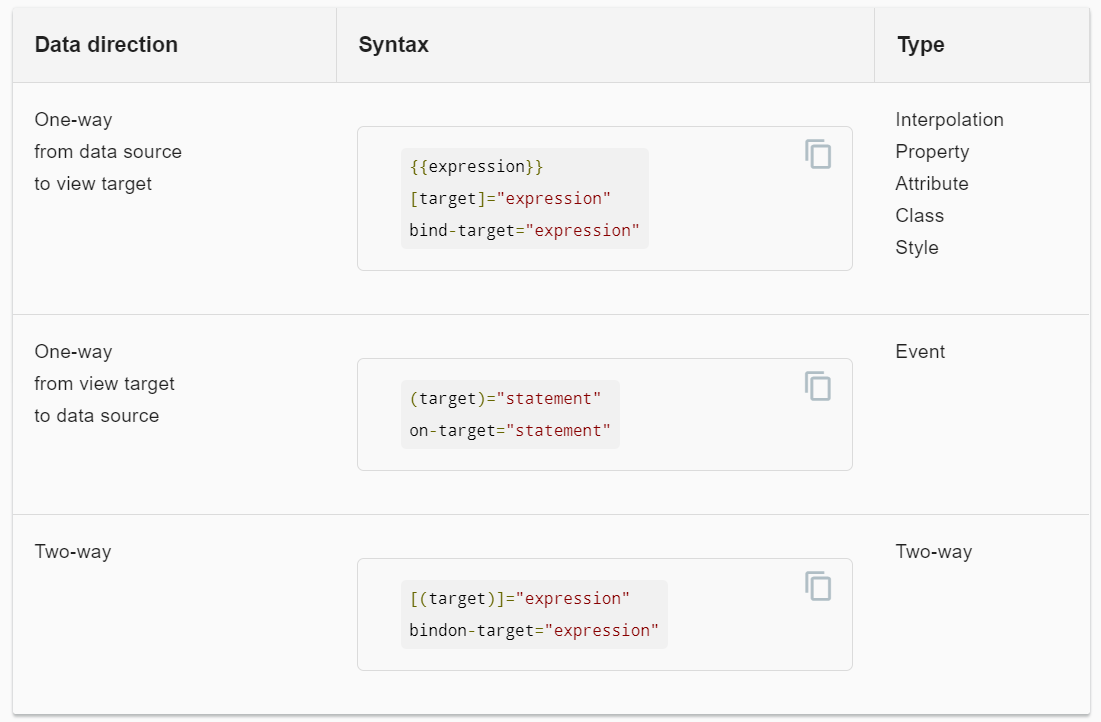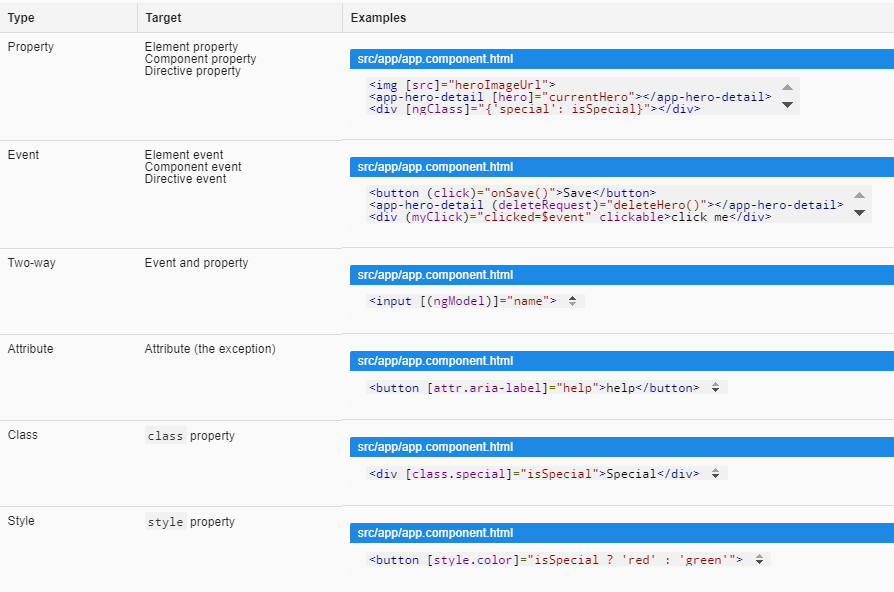綁定類型
綁定類型可以按照數據流的方向分為三類:從源到視圖,從視圖到源,以及雙向序列
示例
<!-- Bind button disabled state to `isUnchanged` property --> <button [disabled]="isUnchanged">Save</button>
綁定對象

Property binding
<img [src]="heroImageUrl"> <img bind-src="heroImageUrl"> <div [ngClass]="classes">[ngClass] binding to the classes property</div>
不要忘記方括號
正確的寫法
<app-hero-detail [hero]="currentHero"></app-hero-detail>
錯誤的寫法
<!-- ERROR: HeroDetailComponent.hero expects a Hero object, not the string "currentHero" --> <app-hero-detail hero="currentHero"></app-hero-detail>
HeroDetail組件的hero屬性需要一個Hero對象,這正是您在屬性綁定中發送的內容:括號告訴Angular評估模板表達式。
如果省略方括號,Angular會將該字符串視為常量並使用該字符串初始化目標屬性。
屬性綁定還是插值?
下面寫法等效
<p><img src="{{heroImageUrl}}"> is the <i>interpolated</i> image.</p> <p><img [src]="heroImageUrl"> is the <i>property bound</i> image.</p> <p><span>"{{title}}" is the <i>interpolated</i> title.</span></p> <p>"<span [innerHTML]="title"></span>" is the <i>property bound</i> title.</p>
Attribute, class, and style bindings
Attribute binding
錯誤的寫法
<tr><td colspan="{{1 + 1}}">Three-Four</td></tr>
報錯
Template parse errors:
Can't bind to 'colspan' since it isn't a known native property
正確的寫法
<!-- expression calculates colspan=2 --> <tr><td [attr.colspan]="1 + 1">One-Two</td></tr>
Class binding
不使用bind
<div class="bad curly special">Bad curly special</div>
使用bind
<!-- reset/override all class names with a binding --> <div class="bad curly special" [class]="badCurly">Bad curly</div>
Style binding
Style binding語法類似於Property binding。 代替括號內的元素屬性,從前綴樣式開始,后跟一個點(.)和一個CSS樣式屬性的名稱:[style.style-property]
<button [style.color]="isSpecial ? 'red': 'green'">Red</button> <button [style.background-color]="canSave ? 'cyan': 'grey'" >Save</button>
一些樣式有一個單位擴展名。
<button [style.font-size.em]="isSpecial ? 3 : 1" >Big</button> <button [style.font-size.%]="!isSpecial ? 150 : 50" >Small</button>
Event binding
兩種寫法
<button (click)="onSave()">Save</button> <button on-click="onSave()">On Save</button>
<input [value]="currentHero.name" (input)="currentHero.name=$event.target.value" >
還可以自定義Event
Two-way binding ( [(...)] )
Angular為雙向綁定提供了一種特殊的雙向數據綁定語法,[(x)]。 [(x)]語法將屬性綁定的括號[x]與事件綁定的括號(x)組合在一起。
[( )] = BANANA IN A BOX
香蕉在一個盒子里
在盒子中形象化一個香蕉,記住圓括號在括號內。
示例
<app-sizer [(size)]="fontSizePx"></app-sizer>
<div [style.font-size.px]="fontSizePx">Resizable Text</div>
雙向綁定語法實際上只是語法綁定和事件綁定的語法糖。
<app-sizer [size]="fontSizePx" (sizeChange)="fontSizePx=$event"></app-sizer>